Inclusive Practices in Education: A Report for Hackney College
VerifiedAdded on 2022/11/13
|25
|5801
|227
Report
AI Summary
This report provides a comprehensive overview of inclusive practices in education, specifically within the context of Hackney College in the UK. It begins with an introduction to inclusive education, defining its core principles and highlighting the legal framework established by the Equality Act 2010. The report then delves into relevant theoretical frameworks, including Maslow's Hierarchy of Needs and Herzberg's Two-Factor Theory, examining their impact on social, cultural, and personal factors affecting learning. Furthermore, the report analyzes policy and regulatory frameworks for inclusive education in the UK, focusing on the policies adopted by Hackney College to promote equality and diversity. It explores the influence of these policies on institutional practices and classroom activities, emphasizing the role of the teacher in fostering an inclusive environment. The report also outlines personal responsibilities and principles of a teacher, including identifying points of referral for students with individual learning needs. The report concludes with an evaluation of the effectiveness of the policies in practice, including a SWOT analysis of the author's teaching method and a personal and professional development plan. Overall, the report aims to provide a practical guide for incorporating inclusive education in a college classroom.
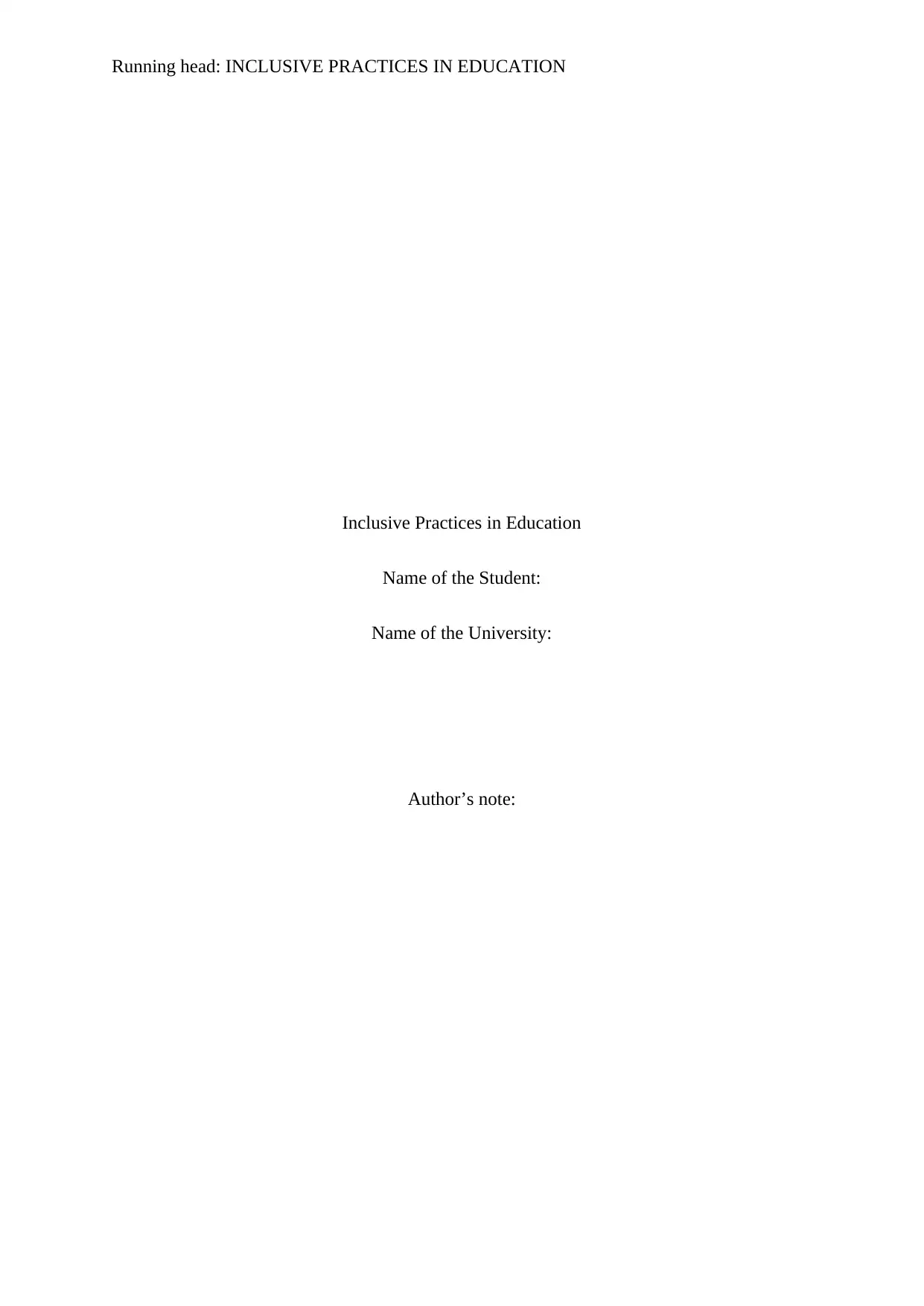
Running head: INCLUSIVE PRACTICES IN EDUCATION
Inclusive Practices in Education
Name of the Student:
Name of the University:
Author’s note:
Inclusive Practices in Education
Name of the Student:
Name of the University:
Author’s note:
Paraphrase This Document
Need a fresh take? Get an instant paraphrase of this document with our AI Paraphraser

1
INCLUSIVE PRACTICES IN EDUCATION
Executive Summary:
The present paper deals with inclusive practices in education. It is more of a report and
strategy for employing effective inclusive practice. To comprehend the notion, first the
concept and definition has been discussed. Further, theories of Maslow and Herzberg
explaining factors of inclusion have been discussed with regard to their impact on social and
personal factors of learning as well as teaching. The concept of equality and diversity has
been explained in reference to UK’s position and vision to promote them. Along with that,
the institutional individual policies implemented towards achieving inclusive education have
been discussed. With the aforementioned information and policies, a strategy improvising
effective methods of inclusive teaching has been tried to develop.
INCLUSIVE PRACTICES IN EDUCATION
Executive Summary:
The present paper deals with inclusive practices in education. It is more of a report and
strategy for employing effective inclusive practice. To comprehend the notion, first the
concept and definition has been discussed. Further, theories of Maslow and Herzberg
explaining factors of inclusion have been discussed with regard to their impact on social and
personal factors of learning as well as teaching. The concept of equality and diversity has
been explained in reference to UK’s position and vision to promote them. Along with that,
the institutional individual policies implemented towards achieving inclusive education have
been discussed. With the aforementioned information and policies, a strategy improvising
effective methods of inclusive teaching has been tried to develop.
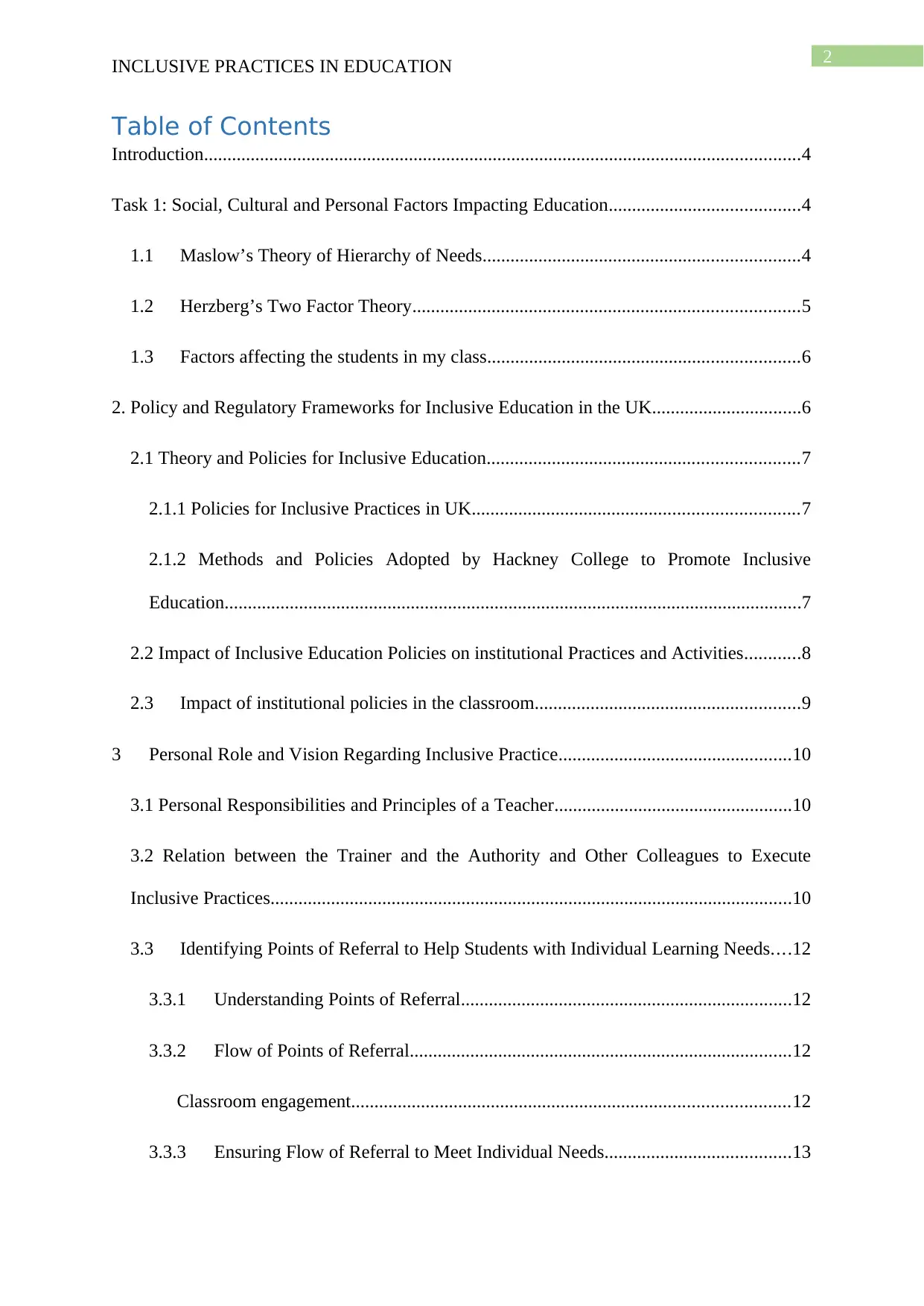
2
INCLUSIVE PRACTICES IN EDUCATION
Table of Contents
Introduction................................................................................................................................4
Task 1: Social, Cultural and Personal Factors Impacting Education.........................................4
1.1 Maslow’s Theory of Hierarchy of Needs....................................................................4
1.2 Herzberg’s Two Factor Theory...................................................................................5
1.3 Factors affecting the students in my class...................................................................6
2. Policy and Regulatory Frameworks for Inclusive Education in the UK................................6
2.1 Theory and Policies for Inclusive Education...................................................................7
2.1.1 Policies for Inclusive Practices in UK......................................................................7
2.1.2 Methods and Policies Adopted by Hackney College to Promote Inclusive
Education............................................................................................................................7
2.2 Impact of Inclusive Education Policies on institutional Practices and Activities............8
2.3 Impact of institutional policies in the classroom.........................................................9
3 Personal Role and Vision Regarding Inclusive Practice..................................................10
3.1 Personal Responsibilities and Principles of a Teacher...................................................10
3.2 Relation between the Trainer and the Authority and Other Colleagues to Execute
Inclusive Practices................................................................................................................10
3.3 Identifying Points of Referral to Help Students with Individual Learning Needs....12
3.3.1 Understanding Points of Referral.......................................................................12
3.3.2 Flow of Points of Referral..................................................................................12
Classroom engagement..............................................................................................12
3.3.3 Ensuring Flow of Referral to Meet Individual Needs........................................13
INCLUSIVE PRACTICES IN EDUCATION
Table of Contents
Introduction................................................................................................................................4
Task 1: Social, Cultural and Personal Factors Impacting Education.........................................4
1.1 Maslow’s Theory of Hierarchy of Needs....................................................................4
1.2 Herzberg’s Two Factor Theory...................................................................................5
1.3 Factors affecting the students in my class...................................................................6
2. Policy and Regulatory Frameworks for Inclusive Education in the UK................................6
2.1 Theory and Policies for Inclusive Education...................................................................7
2.1.1 Policies for Inclusive Practices in UK......................................................................7
2.1.2 Methods and Policies Adopted by Hackney College to Promote Inclusive
Education............................................................................................................................7
2.2 Impact of Inclusive Education Policies on institutional Practices and Activities............8
2.3 Impact of institutional policies in the classroom.........................................................9
3 Personal Role and Vision Regarding Inclusive Practice..................................................10
3.1 Personal Responsibilities and Principles of a Teacher...................................................10
3.2 Relation between the Trainer and the Authority and Other Colleagues to Execute
Inclusive Practices................................................................................................................10
3.3 Identifying Points of Referral to Help Students with Individual Learning Needs....12
3.3.1 Understanding Points of Referral.......................................................................12
3.3.2 Flow of Points of Referral..................................................................................12
Classroom engagement..............................................................................................12
3.3.3 Ensuring Flow of Referral to Meet Individual Needs........................................13
⊘ This is a preview!⊘
Do you want full access?
Subscribe today to unlock all pages.

Trusted by 1+ million students worldwide
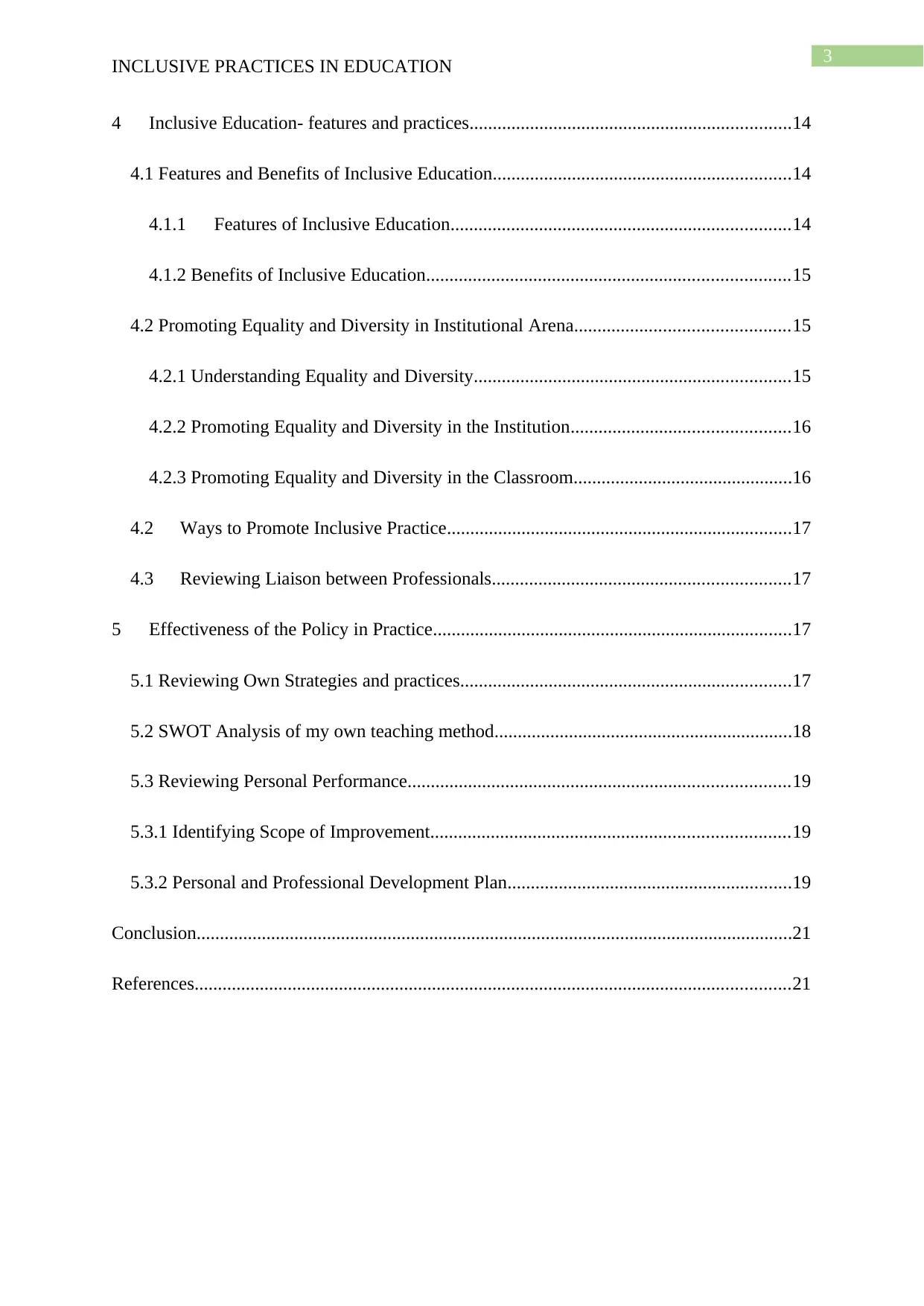
3
INCLUSIVE PRACTICES IN EDUCATION
4 Inclusive Education- features and practices.....................................................................14
4.1 Features and Benefits of Inclusive Education................................................................14
4.1.1 Features of Inclusive Education.........................................................................14
4.1.2 Benefits of Inclusive Education..............................................................................15
4.2 Promoting Equality and Diversity in Institutional Arena..............................................15
4.2.1 Understanding Equality and Diversity....................................................................15
4.2.2 Promoting Equality and Diversity in the Institution...............................................16
4.2.3 Promoting Equality and Diversity in the Classroom...............................................16
4.2 Ways to Promote Inclusive Practice..........................................................................17
4.3 Reviewing Liaison between Professionals................................................................17
5 Effectiveness of the Policy in Practice.............................................................................17
5.1 Reviewing Own Strategies and practices.......................................................................17
5.2 SWOT Analysis of my own teaching method................................................................18
5.3 Reviewing Personal Performance..................................................................................19
5.3.1 Identifying Scope of Improvement.............................................................................19
5.3.2 Personal and Professional Development Plan.............................................................19
Conclusion................................................................................................................................21
References................................................................................................................................21
INCLUSIVE PRACTICES IN EDUCATION
4 Inclusive Education- features and practices.....................................................................14
4.1 Features and Benefits of Inclusive Education................................................................14
4.1.1 Features of Inclusive Education.........................................................................14
4.1.2 Benefits of Inclusive Education..............................................................................15
4.2 Promoting Equality and Diversity in Institutional Arena..............................................15
4.2.1 Understanding Equality and Diversity....................................................................15
4.2.2 Promoting Equality and Diversity in the Institution...............................................16
4.2.3 Promoting Equality and Diversity in the Classroom...............................................16
4.2 Ways to Promote Inclusive Practice..........................................................................17
4.3 Reviewing Liaison between Professionals................................................................17
5 Effectiveness of the Policy in Practice.............................................................................17
5.1 Reviewing Own Strategies and practices.......................................................................17
5.2 SWOT Analysis of my own teaching method................................................................18
5.3 Reviewing Personal Performance..................................................................................19
5.3.1 Identifying Scope of Improvement.............................................................................19
5.3.2 Personal and Professional Development Plan.............................................................19
Conclusion................................................................................................................................21
References................................................................................................................................21
Paraphrase This Document
Need a fresh take? Get an instant paraphrase of this document with our AI Paraphraser
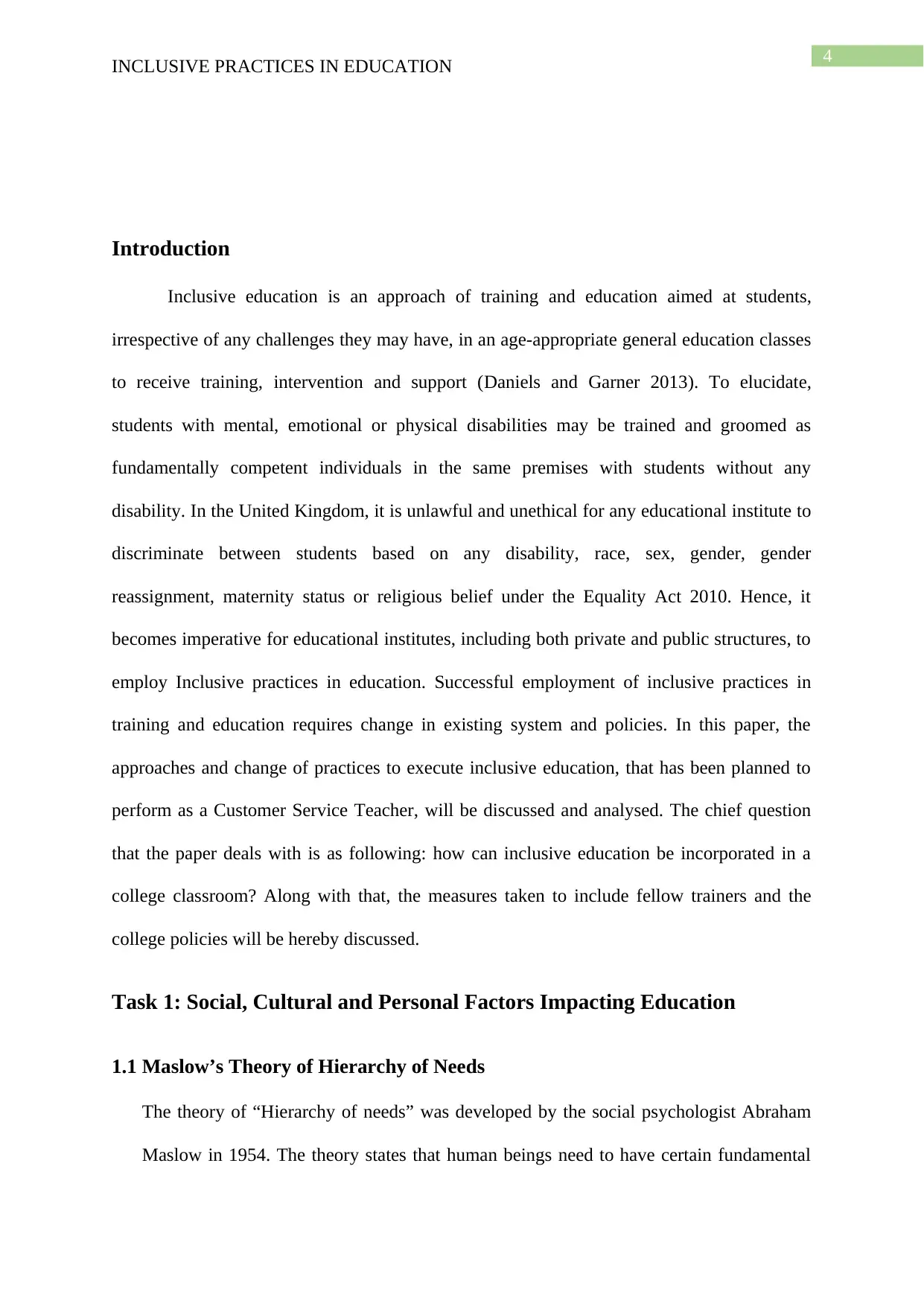
4
INCLUSIVE PRACTICES IN EDUCATION
Introduction
Inclusive education is an approach of training and education aimed at students,
irrespective of any challenges they may have, in an age-appropriate general education classes
to receive training, intervention and support (Daniels and Garner 2013). To elucidate,
students with mental, emotional or physical disabilities may be trained and groomed as
fundamentally competent individuals in the same premises with students without any
disability. In the United Kingdom, it is unlawful and unethical for any educational institute to
discriminate between students based on any disability, race, sex, gender, gender
reassignment, maternity status or religious belief under the Equality Act 2010. Hence, it
becomes imperative for educational institutes, including both private and public structures, to
employ Inclusive practices in education. Successful employment of inclusive practices in
training and education requires change in existing system and policies. In this paper, the
approaches and change of practices to execute inclusive education, that has been planned to
perform as a Customer Service Teacher, will be discussed and analysed. The chief question
that the paper deals with is as following: how can inclusive education be incorporated in a
college classroom? Along with that, the measures taken to include fellow trainers and the
college policies will be hereby discussed.
Task 1: Social, Cultural and Personal Factors Impacting Education
1.1 Maslow’s Theory of Hierarchy of Needs
The theory of “Hierarchy of needs” was developed by the social psychologist Abraham
Maslow in 1954. The theory states that human beings need to have certain fundamental
INCLUSIVE PRACTICES IN EDUCATION
Introduction
Inclusive education is an approach of training and education aimed at students,
irrespective of any challenges they may have, in an age-appropriate general education classes
to receive training, intervention and support (Daniels and Garner 2013). To elucidate,
students with mental, emotional or physical disabilities may be trained and groomed as
fundamentally competent individuals in the same premises with students without any
disability. In the United Kingdom, it is unlawful and unethical for any educational institute to
discriminate between students based on any disability, race, sex, gender, gender
reassignment, maternity status or religious belief under the Equality Act 2010. Hence, it
becomes imperative for educational institutes, including both private and public structures, to
employ Inclusive practices in education. Successful employment of inclusive practices in
training and education requires change in existing system and policies. In this paper, the
approaches and change of practices to execute inclusive education, that has been planned to
perform as a Customer Service Teacher, will be discussed and analysed. The chief question
that the paper deals with is as following: how can inclusive education be incorporated in a
college classroom? Along with that, the measures taken to include fellow trainers and the
college policies will be hereby discussed.
Task 1: Social, Cultural and Personal Factors Impacting Education
1.1 Maslow’s Theory of Hierarchy of Needs
The theory of “Hierarchy of needs” was developed by the social psychologist Abraham
Maslow in 1954. The theory states that human beings need to have certain fundamental
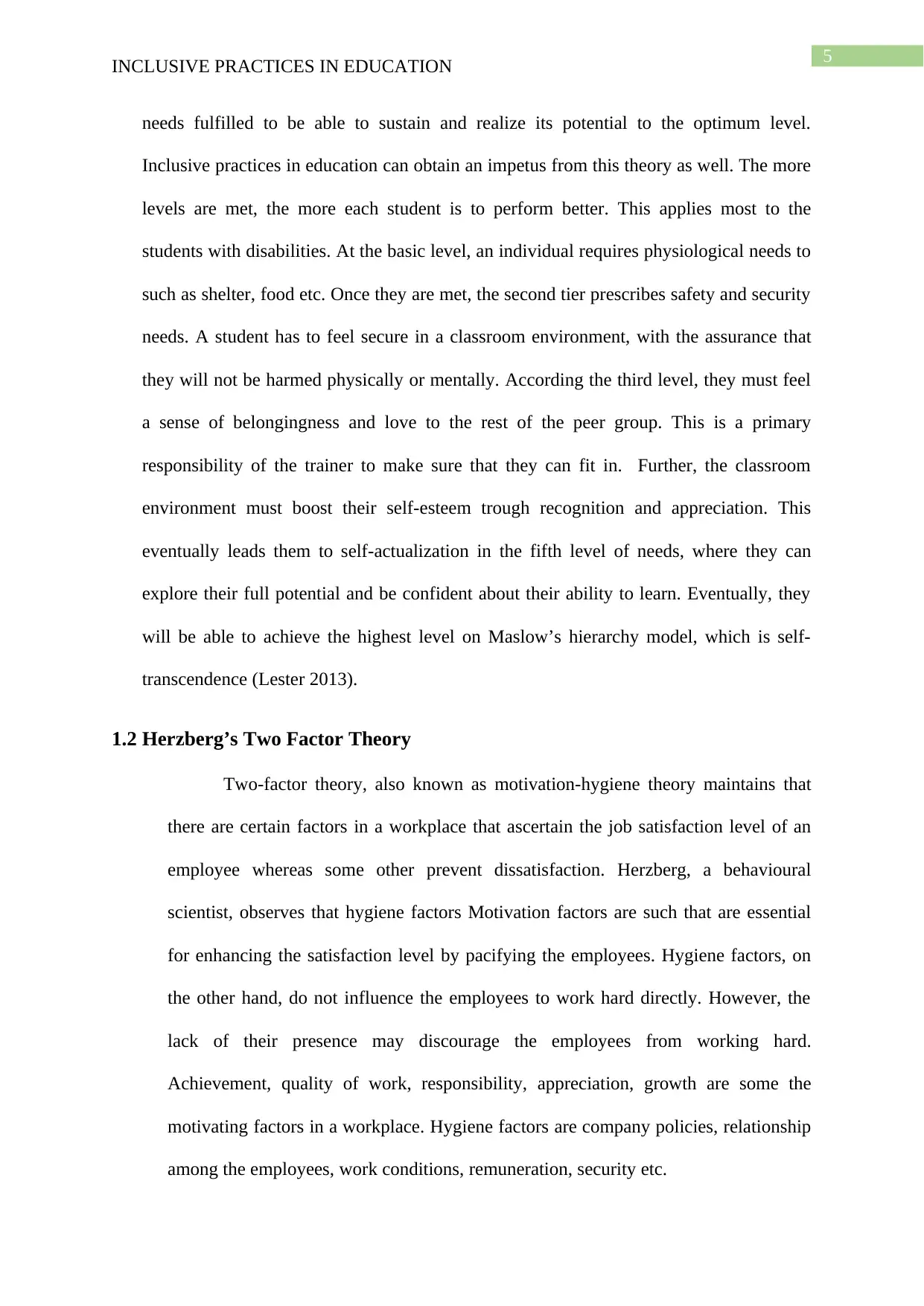
5
INCLUSIVE PRACTICES IN EDUCATION
needs fulfilled to be able to sustain and realize its potential to the optimum level.
Inclusive practices in education can obtain an impetus from this theory as well. The more
levels are met, the more each student is to perform better. This applies most to the
students with disabilities. At the basic level, an individual requires physiological needs to
such as shelter, food etc. Once they are met, the second tier prescribes safety and security
needs. A student has to feel secure in a classroom environment, with the assurance that
they will not be harmed physically or mentally. According the third level, they must feel
a sense of belongingness and love to the rest of the peer group. This is a primary
responsibility of the trainer to make sure that they can fit in. Further, the classroom
environment must boost their self-esteem trough recognition and appreciation. This
eventually leads them to self-actualization in the fifth level of needs, where they can
explore their full potential and be confident about their ability to learn. Eventually, they
will be able to achieve the highest level on Maslow’s hierarchy model, which is self-
transcendence (Lester 2013).
1.2 Herzberg’s Two Factor Theory
Two-factor theory, also known as motivation-hygiene theory maintains that
there are certain factors in a workplace that ascertain the job satisfaction level of an
employee whereas some other prevent dissatisfaction. Herzberg, a behavioural
scientist, observes that hygiene factors Motivation factors are such that are essential
for enhancing the satisfaction level by pacifying the employees. Hygiene factors, on
the other hand, do not influence the employees to work hard directly. However, the
lack of their presence may discourage the employees from working hard.
Achievement, quality of work, responsibility, appreciation, growth are some the
motivating factors in a workplace. Hygiene factors are company policies, relationship
among the employees, work conditions, remuneration, security etc.
INCLUSIVE PRACTICES IN EDUCATION
needs fulfilled to be able to sustain and realize its potential to the optimum level.
Inclusive practices in education can obtain an impetus from this theory as well. The more
levels are met, the more each student is to perform better. This applies most to the
students with disabilities. At the basic level, an individual requires physiological needs to
such as shelter, food etc. Once they are met, the second tier prescribes safety and security
needs. A student has to feel secure in a classroom environment, with the assurance that
they will not be harmed physically or mentally. According the third level, they must feel
a sense of belongingness and love to the rest of the peer group. This is a primary
responsibility of the trainer to make sure that they can fit in. Further, the classroom
environment must boost their self-esteem trough recognition and appreciation. This
eventually leads them to self-actualization in the fifth level of needs, where they can
explore their full potential and be confident about their ability to learn. Eventually, they
will be able to achieve the highest level on Maslow’s hierarchy model, which is self-
transcendence (Lester 2013).
1.2 Herzberg’s Two Factor Theory
Two-factor theory, also known as motivation-hygiene theory maintains that
there are certain factors in a workplace that ascertain the job satisfaction level of an
employee whereas some other prevent dissatisfaction. Herzberg, a behavioural
scientist, observes that hygiene factors Motivation factors are such that are essential
for enhancing the satisfaction level by pacifying the employees. Hygiene factors, on
the other hand, do not influence the employees to work hard directly. However, the
lack of their presence may discourage the employees from working hard.
Achievement, quality of work, responsibility, appreciation, growth are some the
motivating factors in a workplace. Hygiene factors are company policies, relationship
among the employees, work conditions, remuneration, security etc.
⊘ This is a preview!⊘
Do you want full access?
Subscribe today to unlock all pages.

Trusted by 1+ million students worldwide

6
INCLUSIVE PRACTICES IN EDUCATION
1.3 Factors affecting the students in my class
As a trainee teacher of Customer Services at Hackney College, I have the
responsibility to train 40-odd students coming from different social and cultural
backgrounds. Also, there are some students with exceptionalities. First of all, the
curriculum and language employed for teaching the course is always influenced by
certain culture and social practices. Hence, the primary challenge is to accommodate the
students from different backgrounds into an inclusive and open system of education.
Racism and gender discrimination have to be restricted by all means. Also, typical
generalization of a student from a certain cultural background had to be discouraged
strictly (Peters 2015). As for the students of colour, the rest of the class tend to judge all
of them as per the popular African-American culture, the image created by the media and
entertainment platforms. Owing to this tendency, some of the students felt isolated and
misunderstood. Besides, the students with exceptionalities need to feel involved and
confident about their abilities. Compared to other students of the class, a student with
dyslexia or physical disability may find it hard to participate in the class proceedings as
usual. However, strategies must be devised to help them keep up with everyone.
2. Policy and Regulatory Frameworks for Inclusive Education in the UK
Inclusive education, at its base, follows the concept of human rights. As declared by
the Universal Declaration of Human Rights (United Nations 1998), education is a
fundamental human right. Every children, irrespective of having disabilities, are entitled to
education. Inclusive education draws its spirit from this notion of basic human rights and
applies itself against all kinds of discrimination between students (Beveridge 2013).
INCLUSIVE PRACTICES IN EDUCATION
1.3 Factors affecting the students in my class
As a trainee teacher of Customer Services at Hackney College, I have the
responsibility to train 40-odd students coming from different social and cultural
backgrounds. Also, there are some students with exceptionalities. First of all, the
curriculum and language employed for teaching the course is always influenced by
certain culture and social practices. Hence, the primary challenge is to accommodate the
students from different backgrounds into an inclusive and open system of education.
Racism and gender discrimination have to be restricted by all means. Also, typical
generalization of a student from a certain cultural background had to be discouraged
strictly (Peters 2015). As for the students of colour, the rest of the class tend to judge all
of them as per the popular African-American culture, the image created by the media and
entertainment platforms. Owing to this tendency, some of the students felt isolated and
misunderstood. Besides, the students with exceptionalities need to feel involved and
confident about their abilities. Compared to other students of the class, a student with
dyslexia or physical disability may find it hard to participate in the class proceedings as
usual. However, strategies must be devised to help them keep up with everyone.
2. Policy and Regulatory Frameworks for Inclusive Education in the UK
Inclusive education, at its base, follows the concept of human rights. As declared by
the Universal Declaration of Human Rights (United Nations 1998), education is a
fundamental human right. Every children, irrespective of having disabilities, are entitled to
education. Inclusive education draws its spirit from this notion of basic human rights and
applies itself against all kinds of discrimination between students (Beveridge 2013).
Paraphrase This Document
Need a fresh take? Get an instant paraphrase of this document with our AI Paraphraser
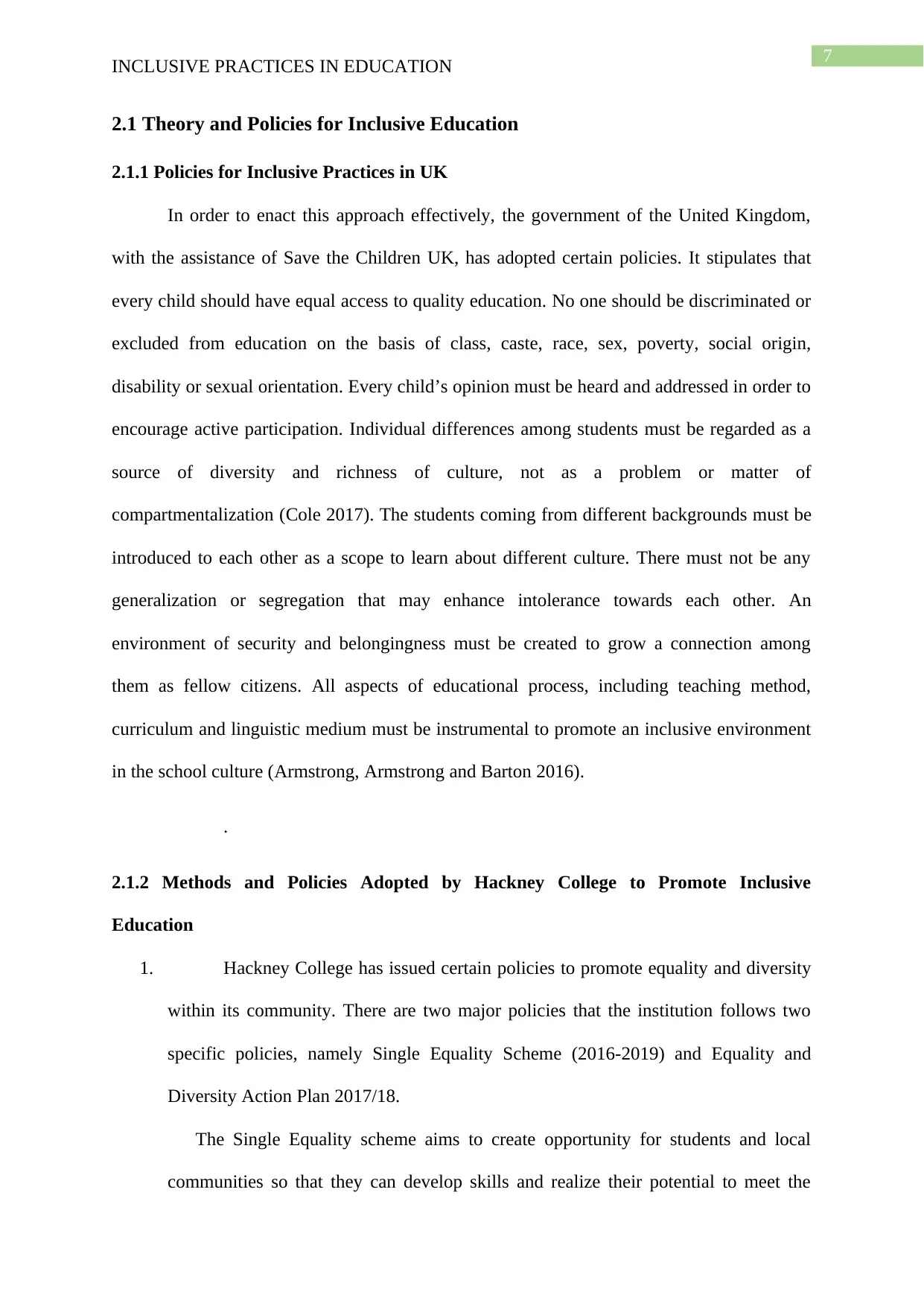
7
INCLUSIVE PRACTICES IN EDUCATION
2.1 Theory and Policies for Inclusive Education
2.1.1 Policies for Inclusive Practices in UK
In order to enact this approach effectively, the government of the United Kingdom,
with the assistance of Save the Children UK, has adopted certain policies. It stipulates that
every child should have equal access to quality education. No one should be discriminated or
excluded from education on the basis of class, caste, race, sex, poverty, social origin,
disability or sexual orientation. Every child’s opinion must be heard and addressed in order to
encourage active participation. Individual differences among students must be regarded as a
source of diversity and richness of culture, not as a problem or matter of
compartmentalization (Cole 2017). The students coming from different backgrounds must be
introduced to each other as a scope to learn about different culture. There must not be any
generalization or segregation that may enhance intolerance towards each other. An
environment of security and belongingness must be created to grow a connection among
them as fellow citizens. All aspects of educational process, including teaching method,
curriculum and linguistic medium must be instrumental to promote an inclusive environment
in the school culture (Armstrong, Armstrong and Barton 2016).
.
2.1.2 Methods and Policies Adopted by Hackney College to Promote Inclusive
Education
1. Hackney College has issued certain policies to promote equality and diversity
within its community. There are two major policies that the institution follows two
specific policies, namely Single Equality Scheme (2016-2019) and Equality and
Diversity Action Plan 2017/18.
The Single Equality scheme aims to create opportunity for students and local
communities so that they can develop skills and realize their potential to meet the
INCLUSIVE PRACTICES IN EDUCATION
2.1 Theory and Policies for Inclusive Education
2.1.1 Policies for Inclusive Practices in UK
In order to enact this approach effectively, the government of the United Kingdom,
with the assistance of Save the Children UK, has adopted certain policies. It stipulates that
every child should have equal access to quality education. No one should be discriminated or
excluded from education on the basis of class, caste, race, sex, poverty, social origin,
disability or sexual orientation. Every child’s opinion must be heard and addressed in order to
encourage active participation. Individual differences among students must be regarded as a
source of diversity and richness of culture, not as a problem or matter of
compartmentalization (Cole 2017). The students coming from different backgrounds must be
introduced to each other as a scope to learn about different culture. There must not be any
generalization or segregation that may enhance intolerance towards each other. An
environment of security and belongingness must be created to grow a connection among
them as fellow citizens. All aspects of educational process, including teaching method,
curriculum and linguistic medium must be instrumental to promote an inclusive environment
in the school culture (Armstrong, Armstrong and Barton 2016).
.
2.1.2 Methods and Policies Adopted by Hackney College to Promote Inclusive
Education
1. Hackney College has issued certain policies to promote equality and diversity
within its community. There are two major policies that the institution follows two
specific policies, namely Single Equality Scheme (2016-2019) and Equality and
Diversity Action Plan 2017/18.
The Single Equality scheme aims to create opportunity for students and local
communities so that they can develop skills and realize their potential to meet the
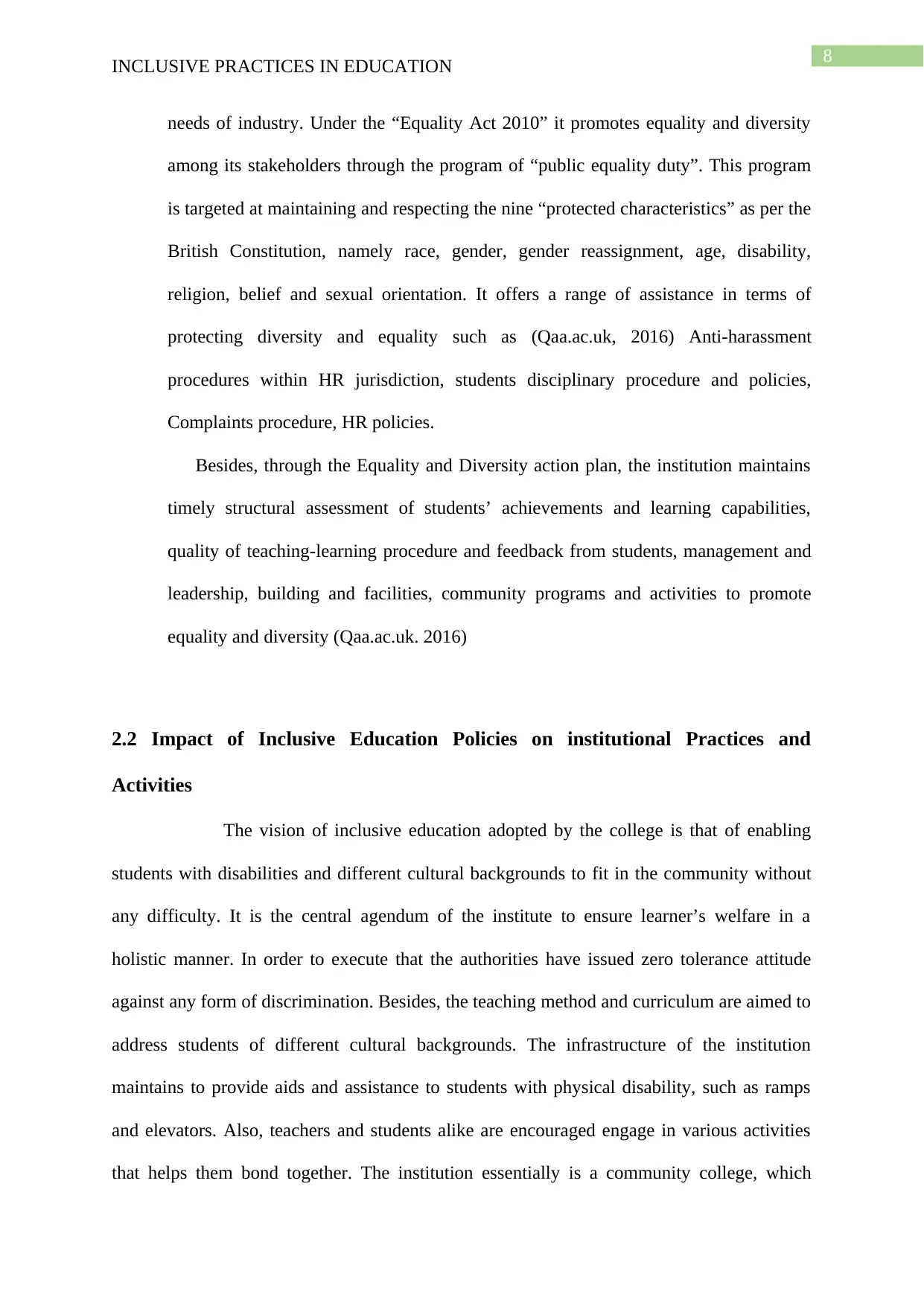
8
INCLUSIVE PRACTICES IN EDUCATION
needs of industry. Under the “Equality Act 2010” it promotes equality and diversity
among its stakeholders through the program of “public equality duty”. This program
is targeted at maintaining and respecting the nine “protected characteristics” as per the
British Constitution, namely race, gender, gender reassignment, age, disability,
religion, belief and sexual orientation. It offers a range of assistance in terms of
protecting diversity and equality such as (Qaa.ac.uk, 2016) Anti-harassment
procedures within HR jurisdiction, students disciplinary procedure and policies,
Complaints procedure, HR policies.
Besides, through the Equality and Diversity action plan, the institution maintains
timely structural assessment of students’ achievements and learning capabilities,
quality of teaching-learning procedure and feedback from students, management and
leadership, building and facilities, community programs and activities to promote
equality and diversity (Qaa.ac.uk. 2016)
2.2 Impact of Inclusive Education Policies on institutional Practices and
Activities
The vision of inclusive education adopted by the college is that of enabling
students with disabilities and different cultural backgrounds to fit in the community without
any difficulty. It is the central agendum of the institute to ensure learner’s welfare in a
holistic manner. In order to execute that the authorities have issued zero tolerance attitude
against any form of discrimination. Besides, the teaching method and curriculum are aimed to
address students of different cultural backgrounds. The infrastructure of the institution
maintains to provide aids and assistance to students with physical disability, such as ramps
and elevators. Also, teachers and students alike are encouraged engage in various activities
that helps them bond together. The institution essentially is a community college, which
INCLUSIVE PRACTICES IN EDUCATION
needs of industry. Under the “Equality Act 2010” it promotes equality and diversity
among its stakeholders through the program of “public equality duty”. This program
is targeted at maintaining and respecting the nine “protected characteristics” as per the
British Constitution, namely race, gender, gender reassignment, age, disability,
religion, belief and sexual orientation. It offers a range of assistance in terms of
protecting diversity and equality such as (Qaa.ac.uk, 2016) Anti-harassment
procedures within HR jurisdiction, students disciplinary procedure and policies,
Complaints procedure, HR policies.
Besides, through the Equality and Diversity action plan, the institution maintains
timely structural assessment of students’ achievements and learning capabilities,
quality of teaching-learning procedure and feedback from students, management and
leadership, building and facilities, community programs and activities to promote
equality and diversity (Qaa.ac.uk. 2016)
2.2 Impact of Inclusive Education Policies on institutional Practices and
Activities
The vision of inclusive education adopted by the college is that of enabling
students with disabilities and different cultural backgrounds to fit in the community without
any difficulty. It is the central agendum of the institute to ensure learner’s welfare in a
holistic manner. In order to execute that the authorities have issued zero tolerance attitude
against any form of discrimination. Besides, the teaching method and curriculum are aimed to
address students of different cultural backgrounds. The infrastructure of the institution
maintains to provide aids and assistance to students with physical disability, such as ramps
and elevators. Also, teachers and students alike are encouraged engage in various activities
that helps them bond together. The institution essentially is a community college, which
⊘ This is a preview!⊘
Do you want full access?
Subscribe today to unlock all pages.

Trusted by 1+ million students worldwide
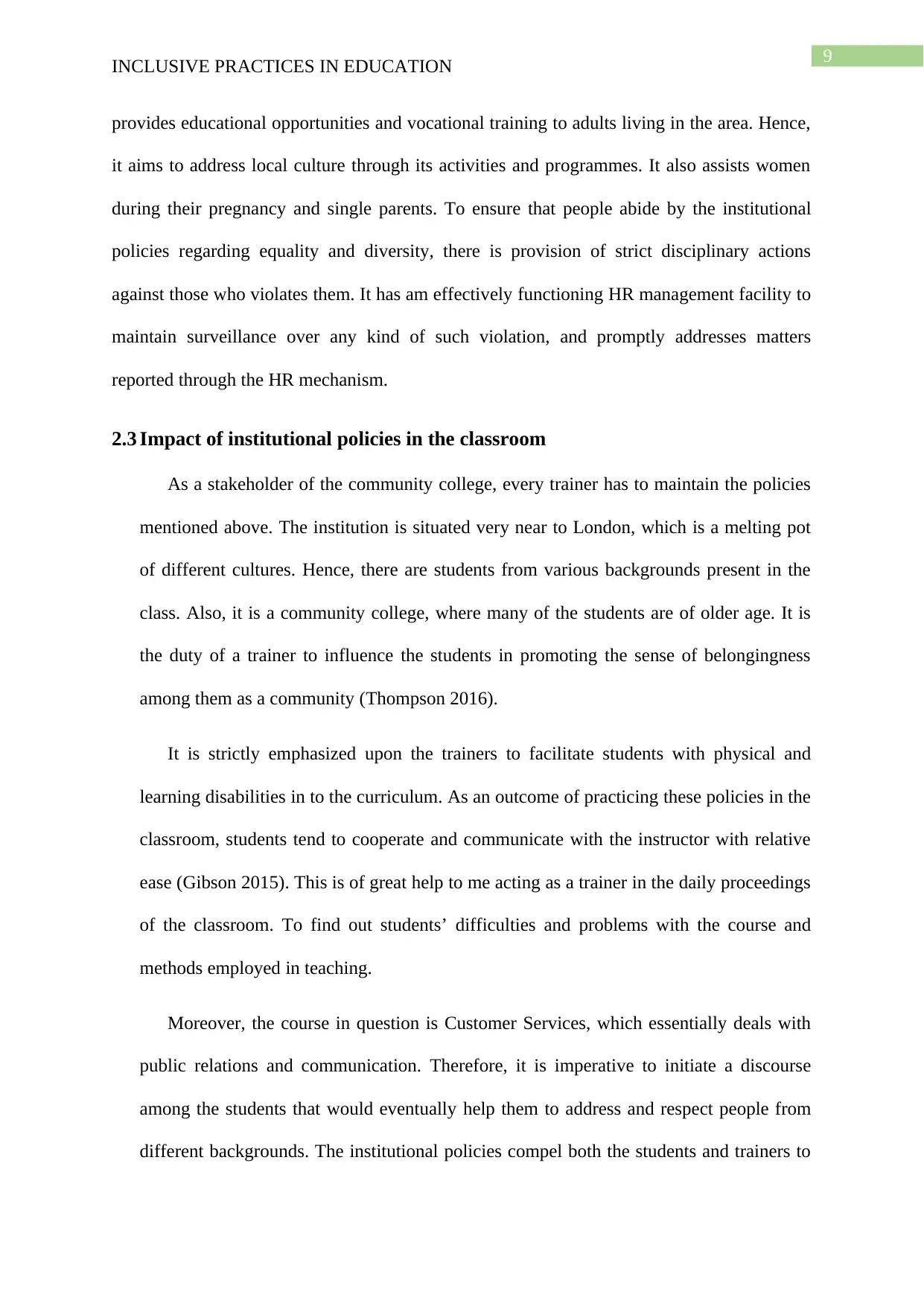
9
INCLUSIVE PRACTICES IN EDUCATION
provides educational opportunities and vocational training to adults living in the area. Hence,
it aims to address local culture through its activities and programmes. It also assists women
during their pregnancy and single parents. To ensure that people abide by the institutional
policies regarding equality and diversity, there is provision of strict disciplinary actions
against those who violates them. It has am effectively functioning HR management facility to
maintain surveillance over any kind of such violation, and promptly addresses matters
reported through the HR mechanism.
2.3 Impact of institutional policies in the classroom
As a stakeholder of the community college, every trainer has to maintain the policies
mentioned above. The institution is situated very near to London, which is a melting pot
of different cultures. Hence, there are students from various backgrounds present in the
class. Also, it is a community college, where many of the students are of older age. It is
the duty of a trainer to influence the students in promoting the sense of belongingness
among them as a community (Thompson 2016).
It is strictly emphasized upon the trainers to facilitate students with physical and
learning disabilities in to the curriculum. As an outcome of practicing these policies in the
classroom, students tend to cooperate and communicate with the instructor with relative
ease (Gibson 2015). This is of great help to me acting as a trainer in the daily proceedings
of the classroom. To find out students’ difficulties and problems with the course and
methods employed in teaching.
Moreover, the course in question is Customer Services, which essentially deals with
public relations and communication. Therefore, it is imperative to initiate a discourse
among the students that would eventually help them to address and respect people from
different backgrounds. The institutional policies compel both the students and trainers to
INCLUSIVE PRACTICES IN EDUCATION
provides educational opportunities and vocational training to adults living in the area. Hence,
it aims to address local culture through its activities and programmes. It also assists women
during their pregnancy and single parents. To ensure that people abide by the institutional
policies regarding equality and diversity, there is provision of strict disciplinary actions
against those who violates them. It has am effectively functioning HR management facility to
maintain surveillance over any kind of such violation, and promptly addresses matters
reported through the HR mechanism.
2.3 Impact of institutional policies in the classroom
As a stakeholder of the community college, every trainer has to maintain the policies
mentioned above. The institution is situated very near to London, which is a melting pot
of different cultures. Hence, there are students from various backgrounds present in the
class. Also, it is a community college, where many of the students are of older age. It is
the duty of a trainer to influence the students in promoting the sense of belongingness
among them as a community (Thompson 2016).
It is strictly emphasized upon the trainers to facilitate students with physical and
learning disabilities in to the curriculum. As an outcome of practicing these policies in the
classroom, students tend to cooperate and communicate with the instructor with relative
ease (Gibson 2015). This is of great help to me acting as a trainer in the daily proceedings
of the classroom. To find out students’ difficulties and problems with the course and
methods employed in teaching.
Moreover, the course in question is Customer Services, which essentially deals with
public relations and communication. Therefore, it is imperative to initiate a discourse
among the students that would eventually help them to address and respect people from
different backgrounds. The institutional policies compel both the students and trainers to
Paraphrase This Document
Need a fresh take? Get an instant paraphrase of this document with our AI Paraphraser
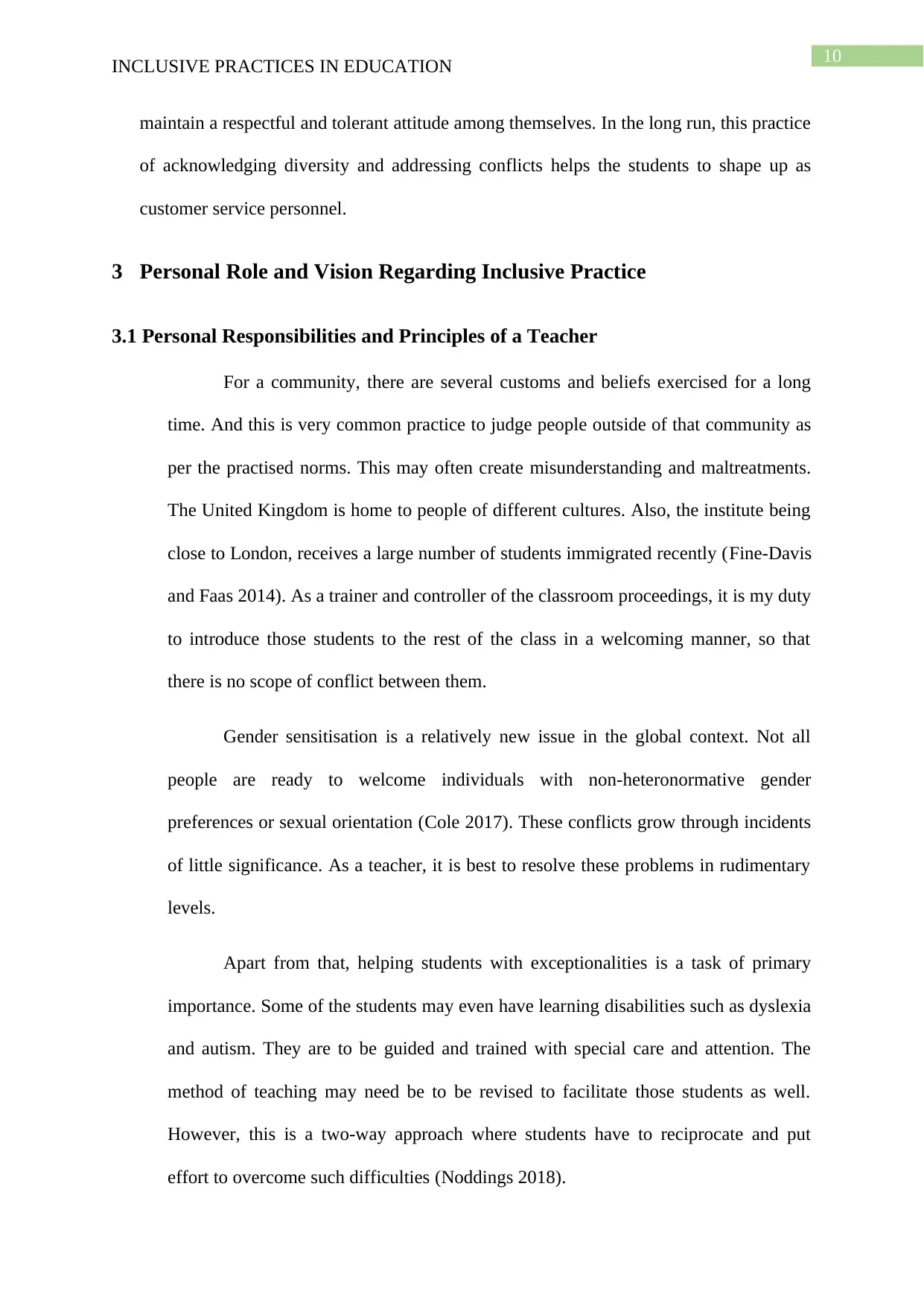
10
INCLUSIVE PRACTICES IN EDUCATION
maintain a respectful and tolerant attitude among themselves. In the long run, this practice
of acknowledging diversity and addressing conflicts helps the students to shape up as
customer service personnel.
3 Personal Role and Vision Regarding Inclusive Practice
3.1 Personal Responsibilities and Principles of a Teacher
For a community, there are several customs and beliefs exercised for a long
time. And this is very common practice to judge people outside of that community as
per the practised norms. This may often create misunderstanding and maltreatments.
The United Kingdom is home to people of different cultures. Also, the institute being
close to London, receives a large number of students immigrated recently (Fine-Davis
and Faas 2014). As a trainer and controller of the classroom proceedings, it is my duty
to introduce those students to the rest of the class in a welcoming manner, so that
there is no scope of conflict between them.
Gender sensitisation is a relatively new issue in the global context. Not all
people are ready to welcome individuals with non-heteronormative gender
preferences or sexual orientation (Cole 2017). These conflicts grow through incidents
of little significance. As a teacher, it is best to resolve these problems in rudimentary
levels.
Apart from that, helping students with exceptionalities is a task of primary
importance. Some of the students may even have learning disabilities such as dyslexia
and autism. They are to be guided and trained with special care and attention. The
method of teaching may need be to be revised to facilitate those students as well.
However, this is a two-way approach where students have to reciprocate and put
effort to overcome such difficulties (Noddings 2018).
INCLUSIVE PRACTICES IN EDUCATION
maintain a respectful and tolerant attitude among themselves. In the long run, this practice
of acknowledging diversity and addressing conflicts helps the students to shape up as
customer service personnel.
3 Personal Role and Vision Regarding Inclusive Practice
3.1 Personal Responsibilities and Principles of a Teacher
For a community, there are several customs and beliefs exercised for a long
time. And this is very common practice to judge people outside of that community as
per the practised norms. This may often create misunderstanding and maltreatments.
The United Kingdom is home to people of different cultures. Also, the institute being
close to London, receives a large number of students immigrated recently (Fine-Davis
and Faas 2014). As a trainer and controller of the classroom proceedings, it is my duty
to introduce those students to the rest of the class in a welcoming manner, so that
there is no scope of conflict between them.
Gender sensitisation is a relatively new issue in the global context. Not all
people are ready to welcome individuals with non-heteronormative gender
preferences or sexual orientation (Cole 2017). These conflicts grow through incidents
of little significance. As a teacher, it is best to resolve these problems in rudimentary
levels.
Apart from that, helping students with exceptionalities is a task of primary
importance. Some of the students may even have learning disabilities such as dyslexia
and autism. They are to be guided and trained with special care and attention. The
method of teaching may need be to be revised to facilitate those students as well.
However, this is a two-way approach where students have to reciprocate and put
effort to overcome such difficulties (Noddings 2018).

11
INCLUSIVE PRACTICES IN EDUCATION
3.2 Relation between the Trainer and the Authority and Other Colleagues to
Execute Inclusive Practices
As a level 3 trainee teacher, there are several tiers of authority that I am answerable
to. The Institution has a structure of hierarchy that helps run the functions properly. The
Community College is currently presided by Ian Ashman, who is also the Principal of the
college and responsible for the overall supervision of the institution. Under his authority,
several Deans operate administrations of specific academic units. Faculty or teachers act
under the direct authority of the Deans. There are tenured faculty members as well as adjunct
faculty members in a certain department. Trainee teachers, such as myself, work along with
the professors. They are assigned with specific subjects and courses. There is also an HR
management body that supervises the disciplinary functions and personnel management.
As the course offers training in Customer Services, for placements and first-hand
industry experience, it is essential to keep a close contact with the corporate organizations
and the facility of apprenticeship program affiliated with the college. Besides, the awarding
body for my own course is Pearson. Therefore, the guidelines and principles of the said
organization is also to be followed. Keeping these affiliations and authority structure in mind,
the discussion will try to portray the necessary relation between them and myself as a trainer
in terms of executing inclusive practices in education.
Working under these authorities compels me to abide by their policies and guidelines
while conducting the classroom proceedings. More importantly, if some new approaches are
to be adopted and followed during the training, it must comply and align with the existing HR
policies and inclusive education guidelines of the institution. However, there is one more
important factor in terms of working with colleagues and authority. The teachers should share
the same notion and attitude towards promoting equality and diversity. Differences of opinion
in this matter may as well impact the practice in a negative way.
INCLUSIVE PRACTICES IN EDUCATION
3.2 Relation between the Trainer and the Authority and Other Colleagues to
Execute Inclusive Practices
As a level 3 trainee teacher, there are several tiers of authority that I am answerable
to. The Institution has a structure of hierarchy that helps run the functions properly. The
Community College is currently presided by Ian Ashman, who is also the Principal of the
college and responsible for the overall supervision of the institution. Under his authority,
several Deans operate administrations of specific academic units. Faculty or teachers act
under the direct authority of the Deans. There are tenured faculty members as well as adjunct
faculty members in a certain department. Trainee teachers, such as myself, work along with
the professors. They are assigned with specific subjects and courses. There is also an HR
management body that supervises the disciplinary functions and personnel management.
As the course offers training in Customer Services, for placements and first-hand
industry experience, it is essential to keep a close contact with the corporate organizations
and the facility of apprenticeship program affiliated with the college. Besides, the awarding
body for my own course is Pearson. Therefore, the guidelines and principles of the said
organization is also to be followed. Keeping these affiliations and authority structure in mind,
the discussion will try to portray the necessary relation between them and myself as a trainer
in terms of executing inclusive practices in education.
Working under these authorities compels me to abide by their policies and guidelines
while conducting the classroom proceedings. More importantly, if some new approaches are
to be adopted and followed during the training, it must comply and align with the existing HR
policies and inclusive education guidelines of the institution. However, there is one more
important factor in terms of working with colleagues and authority. The teachers should share
the same notion and attitude towards promoting equality and diversity. Differences of opinion
in this matter may as well impact the practice in a negative way.
⊘ This is a preview!⊘
Do you want full access?
Subscribe today to unlock all pages.

Trusted by 1+ million students worldwide
1 out of 25
Related Documents
Your All-in-One AI-Powered Toolkit for Academic Success.
+13062052269
info@desklib.com
Available 24*7 on WhatsApp / Email
![[object Object]](/_next/static/media/star-bottom.7253800d.svg)
Unlock your academic potential
Copyright © 2020–2025 A2Z Services. All Rights Reserved. Developed and managed by ZUCOL.




